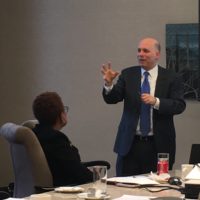I recently heard Dr. Atul Gawande talk about his new book “The Checklist Manifesto.” While the evidence demonstrating the value of checklists for improving the quality of healthcare is increasingly abundant, in his presentation Atul talked about how in a study assessing a surgical checklist they ran into resistance from about 20% of physicians.
Another story he told involved his surgical group’s considering how they might manage bundled reimbursements, e.g. accepting a single payment for all the care and testing related to thyroid cancer surgery. Their discussions came to a screeching halt when it became clear that this “might” mean less money for each of the surgeons. This uncertainty in personal income arose because accepting bundled payments would require them to distribute money among the people and organizations involved in the actual surgery, the pre and post surgical testing, and the follow-up, which can be a very complicated process.
His group of surgeons probably found this change too daunting because they didn’t have an overarching group/entity to help them assess how to distribute/divide a bundled payment, and actually manage and monitor the money and their financial performance. While they are part of Partners in Boston – a large integrated health system that includes the Mass General and Brigham and Women’s hospitals – it seems that Partners hasn’t reached the point of providing this type of support for their individual medical groups.
In the broader world of health deliver reform, to manage such bundled payments effectively physician groups might need to become part of – or affiliate with/have relationships with – medical homes and/or accountable care organizations. If every group of physicians – particularly in a single specialty – had to figure out on their own how to accept and manage bundled payments, it is very unlikely to work, leaving us with our current perverse incentives of fee-for-service reimbursements that promote volume over quality.
What these two stories have in common is that they involve the barriers to positive transformations of clinical medicine. Specifically, fee-for-service’s financial incentives give many clinicians few reasons to change to bundled payments or other reimbursement systems that don’t prioritize volume and don’t reward quality outcomes. Similarly, increasing the use of checklists and other care improving protocols faces significant barriers because while they don’t attack clinicians’ incomes, they can be seen as assaulting their professional autonomy.
Change Agents and Care Delivery Transformation
Part of the solution to both these challenges are support mechanisms to assuage clinicians’ concerns about loss of income and autonomy. The simplest way to conceptualize these support mechanisms is as “Change Agents.” For bundled payments, clinicians need some trusted group or organization that can help them understand how they will be compensated, what information they will get and how to use it, and how bundled payments may actually simplify their professional lives and even potentially increase their incomes – assuming they can practice more efficiently and effectively. For example, because medical care has become so complicated – with an ever expanding array of advanced diagnostic and therapeutic options – the use of checklists and protocols can help clinicians standardize the routine parts of care and thus cognitively free them up to focus on patients’ individual needs and goals, including how to optimize adherence to treatment plans. These changes will improve clinical outcomes, which is what patients want, and economic outcomes, which is what society wants because it will help stimulate the economy and make it easier to expand insurance coverage and access to care.
While Change Agents to support the successful adoption of bundled payments may be some combination of administrative groups and other clinicians who’ve successfully used the new reimbursement scheme, Change Agents for care innovations are most often other clinicians. Typically these clinician Change Agents have real world experience showing how the innovation has actually improved the quality of care – particularly by saving an individual life or preventing a specific adverse event. (Dr. Gawande’s research group saw this in their surgical checklist study, and I found this in researching the use of telemedicine in intensive care units.)
Patients as Change Agents
Patients can also be Change Agents. As I’ve previously written, if patients asked their doctors if they use checklists for things like surgery and inserting central IV lines, and then refused care from physicians (or institutions) that don’t use such checklists, there would likely be rapid adoption of these and other innovations as they are validated and their value communicated broadly. Advocacy organizations can also fill this role, as can government agencies as part of their quality improvement activities through programs such as Medicare, Medicaid and the Veterans Health Administration – something I’ve also raised in a previous post.
Conclusions
Improving quality and slowing the grow in healthcare costs will require multipronged strategies. What these strategies will have in common is that they will confront the significant barriers clinicians have in changing how they practice medicine. Achieving this will require Change Agents – clinicians, patients, advocates, and government agencies who can demonstrate and support the value of care innovations. Simple? No. Possible? Yes. But as the pair of old sayings go: If it was easy anyone could do it. And if it was easy, someone would have done it already.


[…] not the specific decisions made by clinicians for individual patients. Similarly, the use of surgical checklists is an operational process that has been shown to reduce errors, increase the quality of care, and […]